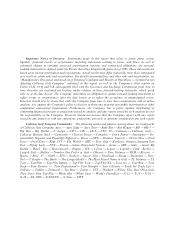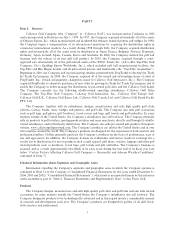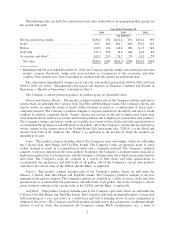Callaway 2004 Annual Report Download - page 17
Download and view the complete annual report
Please find page 17 of the 2004 Callaway annual report below. You can navigate through the pages in the report by either clicking on the pages listed below, or by using the keyword search tool below to find specific information within the annual report.others, should be considered in assessing the Company's future prospects and prior to making an investment
decision with respect to the Company's stock.
Item 2. Properties
The Company and its subsidiaries conduct operations in both owned and leased properties. The
Company's principal executive oÇces and domestic operations are located in Carlsbad, California. The eight
buildings utilized in the Company's Carlsbad operations include corporate oÇces, manufacturing, research
and development, warehousing and distribution facilities. These buildings comprise approximately
735,000 square feet. The Company owns seven of these properties, representing approximately 585,000 square
feet of space. An additional property, representing approximately 150,000 square feet of space, is leased and
the lease is scheduled to expire in November 2007. As part of the Top-Flite Acquisition, the Company
acquired the Chicopee manufacturing plant, warehouse and oÇces that encompass approximately
869,000 square feet and a manufacturing plant in Gloversville, New York comprising approximately
70,000 square feet. In addition, the Company owns and leases a number of other properties domestically and
internationally, including properties in Australia, Canada, Japan, Korea and the United Kingdom. The
Company's operations at each of these properties are used to some extent for both the golf club and golf ball
businesses. The Company believes that its facilities currently are adequate to meet its requirements.
Item 3. Legal Proceedings
In conjunction with the Company's program of enforcing its proprietary rights, the Company has initiated
or may initiate actions against alleged infringers under the intellectual property laws of various countries,
including, for example, the U.S. Lanham Act, the U.S. Patent Act and other pertinent laws. Defendants in
these actions may, among other things, contest the validity and/or the enforceability of some of the
Company's patents and/or trademarks. Others may assert counterclaims against the Company. Historically,
these matters individually and in the aggregate have not had a material adverse eÅect upon the Ñnancial
position or results of operations of the Company. It is possible, however, that in the future one or more
defenses or claims asserted by defendants in one or more of those actions may succeed, resulting in the loss of
all or part of the rights under one or more patents, loss of a trademark, a monetary award against the Company
or some other material loss to the Company. One or more of these results could adversely aÅect the
Company's overall ability to protect its product designs and ultimately limit its future success in the
marketplace.
In addition, the Company from time to time receives information claiming that products sold by the
Company infringe or may infringe patent or other intellectual property rights of third parties. It is possible that
one or more claims of potential infringement could lead to litigation, the need to obtain licenses, the need to
alter a product to avoid infringement, a settlement or judgment, or some other action or material loss by the
Company.
In the fall of 1999 the Company adopted a unilateral sales policy called the ""New Product Introduction
Policy'' (""NPIP''). The NPIP sets forth the terms on which the Company chooses to do business with its
customers with respect to the introduction of new products. The NPIP has been the subject of several legal
challenges. Currently pending cases, described below, include Lundsford v. Callaway Golf, Case
No. 2001-24-IV, pending in Tennessee state court (""Lundsford I''); Foulston v. Callaway Golf, Case
No. 02C3607, pending in Kansas state court; Murray v. Callaway Golf Sales Company, Case
No. 3:04CV274-H, pending in the United States District Court for the Western District of North Carolina;
and Lundsford v. Callaway Golf, Civil Action No. 3:04-cv-442, pending in the United States District Court for
the Eastern District of Tennessee (""Lundsford II''). An adverse resolution of the NPIP cases could have a
signiÑcant adverse eÅect upon the Company's results of operations, cash Öows and Ñnancial position.
Lundsford I was Ñled on April 6, 2001, and seeks to assert a punitive class action by plaintiÅ on behalf of
himself and on behalf of consumers in Tennessee and Kansas who purchased select Callaway Golf products
covered by the NPIP on or after March 30, 2000. PlaintiÅ asserts violations of Tennessee and Kansas antitrust
and consumer protection laws and is seeking damages, restitution and punitive damages. The court has not
8
























